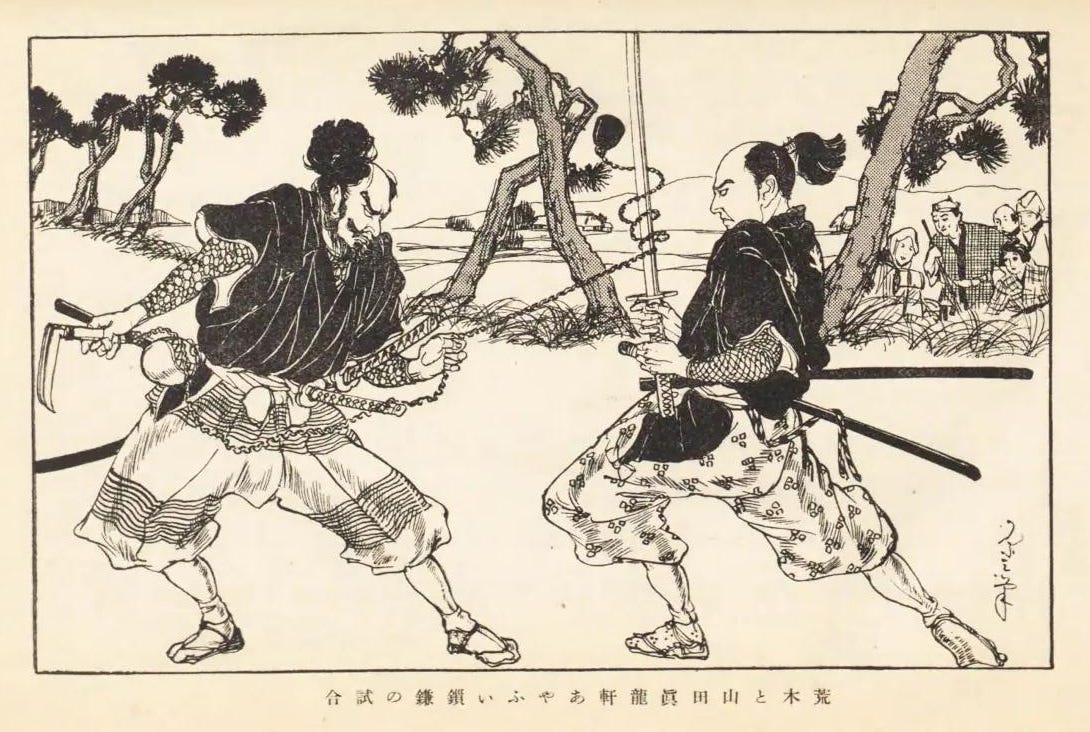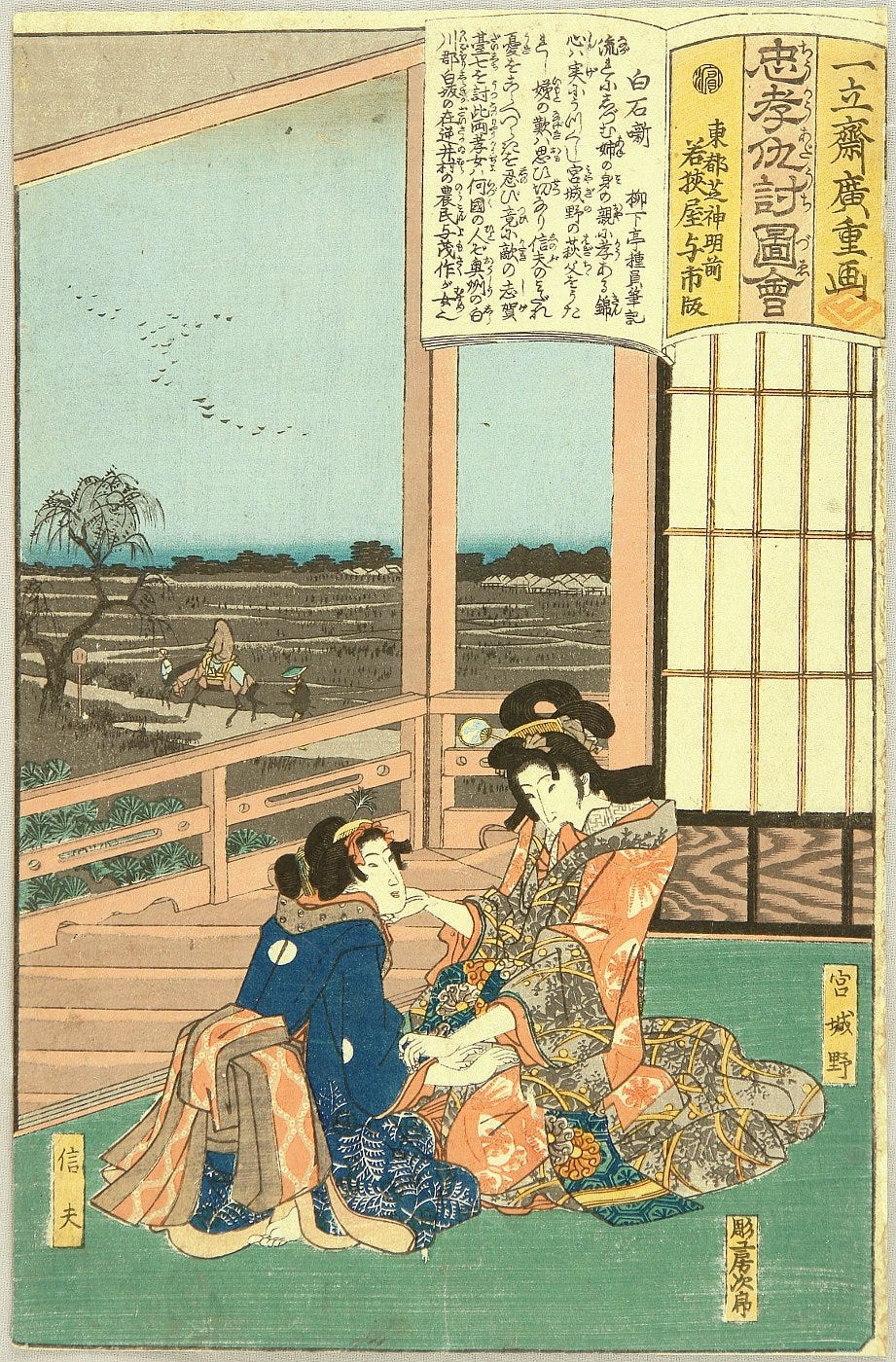Honestly, The Kusari-gama Doesn't Seem Like That Great a Weapon
I'm just going to come out and say it

One of the things you might have noticed in reading through the accounts of the kusari-gama over the years is that the actual results of using the weapon appear decidedly mixed. In two of the three Edo-period stories we looked at, for instance, the kusari-gama user ends up dead when their opponent finds a way to counter the weapon: Shishido gets a throwing-knife in the chest from Miyamoto Musashi, while Yamada Shinryūken manages to tangle his opponent’s sword with his chain, but is then caught out when his opponent drops the tangled sword and draws another one.

Jay Gluck’s version of Yamada Shinryūken’s death - for which I have so far been unable to identify a Japanese source - is quite different, suggesting that Araki Mataemon lured Yamada into a bamboo grove, where the bamboo stalks prevented him from swinging the chain part of the weapon. The sisters Miyagino and Shinobu had rather better results against their father’s killer, but then again, back in the real world the duelist seen in action by the Spectator writer in 1873 came out no better than even against his sword-wielding opponent.

With regard to the “ninja specialized in kusari-gama” claim, then, all of the above raises another potential objection, less to do with the historical evidence and more to do with practicality. On a fairly basic level, the kusari-gama seems like it has some significant limitations as weapon, and so, rather than asking whether ‘ninja’ used the kusari-gama, you could just as easily ask why they would use it in the first place.
Historical Weapons: Not Straightforward
As I noted a few months back when we talked about shuriken, you have to be careful when dealing with the history of weaponry. We’re centuries removed from actual medieval warfare now, and that distance in time has given all sorts of people all sorts of opportunities to make up all sorts of fanciful bullshit. With that in mind, it’s probably helpful to distinguish among different categories of weapon. One category is what we might term “life-or-death” weapons, the ones you would use in a situation where someone was genuinely trying to kill you. Into this category would fall things like bows, firearms, pikes, glaives and other pole-arms, all of which were generally the weapons of choice on the battlefield in medieval Japan, because they were straightforward to use, could be wielded by troops working in formation, and allowed you to fight at a distance.
I don’t think anyone, even the most ardent ‘ninja’ enthusiasts, argues that the kusari-gama was this category of battlefield weapon. As Imamura Yoshio notes in Classified Guide to Japanese Martial Arts, though there may be evidence for hooked pole-arms being used on the battlefield, the path of development of the kusari-gama itself strongly suggests that it was used as a personal armament used for dueling, not a battlefield weapon.1
Especially after the end of regular warfare at the close of the Warring States period (1467-1600), martial training in Japan gradually became more stylized and less concerned with demonstrable combat efficiency. For that reason, we also have to acknowledge the existence of display or training weapons, - weapons that might be used to develop strength and hand-eye coordination. These would typically only be used in the context of training in the martial arts, or in pre-arranged, set piece duels between opponents who were looking to hone their skills or put on a show rather than to kill each other. That’s what Jay Gluck, quoting prominent karate master Oyama Masutatsu, seems to have concluded about the kusari-gama in 1962:
Kusarigama technique is taught in karate – not because it is of any value whatever in combat (Oyama said it was useless), but because it develops speed of observation and reaction. And it’s fun.2
My strong hunch is that in most cases the kusari-gama fell into this category of training or display weapons. The implication of Imamura’s comment that the kusari-gama was not a battlefield weapon, it seems to me, is that the weapon was in some sense sub-optimal, that it could not be relied upon as a general-purpose armament in the chaos of open battle. Rather, it was a weapon that would be most effective in specific situations and contexts. Like, for instance, set-piece duels, where you would face only one opponent, and do so within an arena that could be known in advance. This might explain why all of the accounts we’ve read about people using the kusari-gama are one-on-one duels, as even the sisters Miyagino and Shinobu, whose story has them using the weapon in mortal combat, fought their father’s killer with the terms of engagement known ahead of time.
Right off the bat, the above would seem to constitute a compelling argument against ‘ninja’ using the kusari-gama. If, as the pop version has it, the ‘ninja’ were skilled and supremely practical spies and assassins, it’s hard to understand why they would carry a weapon that might be useless in some of the situations they could expect to encounter.
As we’ll explore below, Imamura is far from the only author to voice skepticism about the kusari-gama’s overall utility. One immediate issue:
You’d Need A Lot of Room to Use It
I don’t know what Jay Gluck’s source might have been for his story of Araki Mataemon defeating Yamada Shinryūken by luring him into a bamboo grove, but the point of the story is fairly clear: the chain part of the weapon would only be usable in wide open spaces. Any space smaller than the radius of the length of the swinging chain would mean the chain would keep banging into things and could not maintain momentum. For the sake of argument, let’s use William Deal’s specs in his Handbook to Life in Medieval and Early Modern Japan, where he suggests that the chain on a kusari-gama was two to three meters/6.5 to 10 feet long. So if we posit that a fighter would swing a length of chain equivalent to three-quarters of the total length (you need to hold on to something, after all), that would seem to mean the weapon would be impractical in any space narrower than about four meters/15 feet across. The radius would be equivalent to double the length being swung, because you’d have to swing the chain in a circle to get maximum momentum, like Kagemaru does with his chain in the 1962 manga Ninja: The Arts of War:
That seems like a pretty significant limitation for the kinds of contexts the ‘ninja’ are supposed to have operated in, like sneaking along castle corridors and into bedrooms in search of their victims. This perhaps explains why the kusari-gama seems to crop up so often in set-piece duels; the wielder had to know for certain that he or she would have the space to use it to its full potential.
It’s Kind of An All-or-Nothing Weapon
And of course duels by definition imply only one opponent, which seems like a further limitation. Although you might be able to hold off multiple opponents by swinging the chain like Kagemaru above, if you used the weapon as it was apparently supposed to be used and tangled your enemy’s sword with the chain, it seems like you’d then be committed - literally attached to that one opponent - and vulnerable if other enemies appeared, or if your opponent simply dropped his sword and pulled another weapon, as Araki Mataemon did in the story above. Plus, the weapon doesn’t seem like it could be readied and used all that quickly, like if the wielder were caught by surprise; depending on its weight, the chain might well take several seconds to get up to speed. If we follow the pop-culture image of the ‘ninja’ sneaking through the castle, running into an unexpected guard or three seems like a scenario that had a decent chance of coming to pass, making the kusari-gama a dubious choice at best.
I imagine this is why Deal writes the following:
The effectiveness of the kusarigama depended largely on surprise and rapid deployment, and along with other ninja weapons and methods was seen as less noble than other pursuits such as spear-throwing or sword-drawing.
This is by way of saying that the weapon had some significant limitations, especially in certain scenarios that ‘ninja,’ by virtue of their role, are supposed to have been likely to encounter.
So I doubt very much that the kusari-gama was ever a ‘ninja’ weapon in any meaningful sense, for the reasons I’ve laid out. From an historical point of view we can show that the weapon was in widespread general use by the early Edo period, and that sources before about 1960 or so don’t mention any shinobi connection. But we can also call the ‘ninja’ association into question on grounds of plausibility and practicality. If we adopt the more recent perspective that shinobi were primarily spies rather than assassins or warriors, too, then the idea of a signature weapon makes little sense. As Yoshimaru Katsuya points out with regard to shuriken, if you actually are a spy, then carrying a weapon everyone associates with spies is probably not a good idea.3 (“Boss, we captured this guy carrying a Walther PPK and a martini, shaken not stirred. No idea who he is.”)
To re-state my point above, my strong hunch is that the kusari-gama in pre-modern Japan was mostly a training and dueling weapon, used as part of a program of stylized martial arts and in duels where the environment and conditions allowed its deployment. I doubt that it was regularly used in life-and-death situations; the bloody duels of Miyamoto Musashi vs Shishido, of Miyagino and Shinobu vs. Danshichi, and of Yamada Shinryūken vs. Araki Mataemon may all be famous, but they’re very likely fictional or at least heavily embellished.
For the record, I am not really a fan of the kind of discussion I’ve just laid out above. This sort of thing tends to devolve into little more than what a bunch of guys in the 21st century judge medieval warfare must have really been like. I’m a middle-aged suburban academic; I know literally nothing about life-or-death combat. Bear that in mind, then, when I venture my opinions about how the kusari-gama might or might not have worked, or what would have happened if you used it on the battlefield, or whatever. Understand that I’m basically full of shit, and so is everyone else; all of this is based on a laughably anachronistic sense of what might have been plausible or practical in terms of killing people.
Anyway, I think we’ve said enough about the kusari-gama for now. For our next post or two, I want to turn to my favorite topic - me - and talk about the peer-reviewed publication on ‘ninja’ I just scored in a major Japan Studies journal.
Imamura Yoshio 今村嘉雄, “Kusarigama no hassei 鎖鎌の発生 [Origins and Development of the Kusari-gama]” in Nihon budō taikei (Dōhōsha, 1982), 7:529. Japanese: 合戦の武器というよりも、個人的勝負の武器に変化していったものであろう。
Jay Gluck, Zen Combat (1962; my ed., 1996), p. 148.
“If [shuriken] were a distinctive weapon that only shinobi carried, then you would be identified as a shinobi should you be searched.” Yoshimaru Katsuya, Ninja to wa nani ka (Kadokawa Sensho, 2023), p. 331. Japanese: 忍びしか持たない特別な武器であれば、身体検査をされたときに忍びだとわかってしまうだろう。





Is there any interesting history to the Yoshimatsu’s story? When I hear “igagoe” I naturally think of Tokugawa Ieyasu’s passing through Iga (and Hattori’s involvement). The work itself is a 20th Century piece, but is there maybe any predecessor in the history of Japanese literature? Thank you.